Anemia in dogs (i.e. low red blood cell numbers) is a symptom of many different diseases, so it can be difficult to know what it might mean for your dog. Integrative veterinarian Dr. Julie Buzby hopes to clear up some confusion by discussing the types, diagnosis, treatment, prognosis, and prevention of anemia in dogs.

Blood. You can’t live without it, but just the thought of it makes some people squeamish.
Arguably, blood’s most important job is to transport oxygen from the lungs to all the organs, tissues, and cells of the body to keep them alive. Once that oxygen is off-loaded, the blood carries the waste product carbon dioxide back to the lungs to be exhaled.
Red blood cells (and the oxygen-carrying molecule hemoglobin within those cells) are the components of the blood tasked with this vital oxygen-transporting job. You can think of the red blood cells in your dog’s blood as the delivery trucks for oxygen. And the molecule hemoglobin in the red blood cell is the delivery person who drops the package at your door.
When you think about it—and please only think about it if the thought of blood doesn’t make you pale and clammy—it really is a remarkably elegant and impressive system.
However, anemia in dogs can throw a wrench in this system by taking some of the delivery trucks (red blood cells) and delivery drivers (hemoglobin) off the road.
- What is anemia in dogs?
- What are the symptoms of anemia in dogs?
- How is anemia diagnosed in dogs?
- What are the types of anemia in dogs?
- How does the vet determine which type of anemia a dog has?
- What is the treatment for anemia in dogs?
- What is the prognosis for dogs with anemia?
- Are there ways to prevent anemia in dogs?
- Tackle anemia in dogs with the help of your vet
- Have you dealt with anemia in your dog?
What is anemia in dogs?
If your vet tells you that your pup has anemia in dogs, it means your dog has a low red blood cell count or low hemoglobin levels. Anemia is not a disease itself, but rather a symptom of a variety of different medical issues. And depending on how low the red blood cell numbers are, it may be mild, moderate, or severe.
As you can imagine, the result of either low red blood cells or low hemoglobin levels is the same—your dog’s cells, tissues, and organs are unable to get the oxygen they need to function appropriately. However, you need not immediately panic if your canine companion has been diagnosed with anemia. Generally speaking, the body can compensate fairly well.
Mild to moderate anemia
While mild and moderate anemias certainly should not be ignored, they are usually not immediately life-threatening. Your veterinarian should have time to try to get to the root of the problem with additional testing. And in many cases, you can work together to find a targeted treatment to get your dog’s red blood cell counts back to normal.
Severe anemia
However, if moderate anemia goes undetected and progresses to become severe anemia or a dog suddenly develops severe anemia (e.g. due to severe and rapid blood loss), that becomes a much bigger problem. In severe anemia, the red cell count or hemoglobin level drops below a critical threshold and the body can no longer compensate. As a result, your dog’s organs can begin to shut down from lack of oxygen. And, unfortunately, severe anemia can become fatal if it is not quickly addressed.
What are the symptoms of anemia in dogs?
The good news is that you can easily assess your dog at home for one of the most classic anemia signs in dogs. This technique I’m about to explain doesn’t require any special medical equipment and only takes a few seconds.
Watch for the biggest sign of anemia—pale pink gums
It turns out that the secret to catching anemia as soon as possible is as simple as lifting your dog’s lip.
If you were to ask me or most any other vet what the most common and biggest sign of anemia in dogs would be, they would most likely say pale pink or almost white gums (and pale lips, conjunctiva, and other mucous membranes).
Gum color is something that vets pay close attention to during a physical exam because it can shed a lot of light on what is going on with the dog. For example, yellow gums can point to liver disease in dogs. Red gums in dogs might indicate the dog has heat stroke, dental disease, or sepsis. And moderately to severely anemic dogs will have pale pink or white gums.
How to check for anemia
Therefore, if you are wondering if your dog is anemic, the easiest way to check is to gently lift the lip to look at the gums. Your dog’s gums should be a nice bright pink.
The first photo below shows a dog with healthy, pink gums. The second photo shows a dog with gums that are pale pink (almost white), which is a sign of anemia.
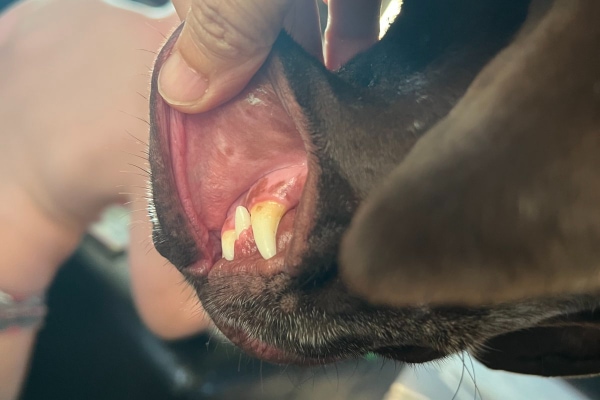
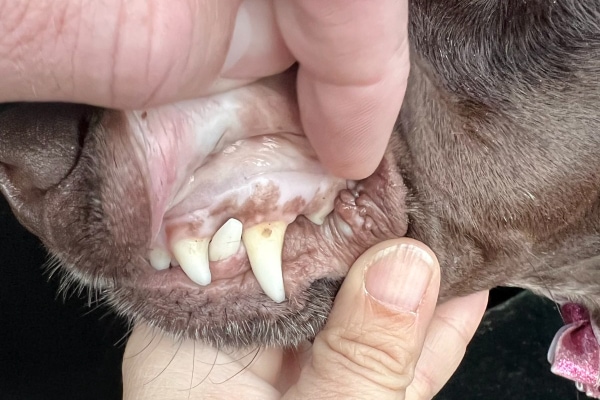
If your dog is showing other signs of not feeling well and the gums are pale pink, you should consult your veterinarian. And if you notice gums that are almost white combined with signs of illness, your dog should have an emergency vet visit immediately. White gums may indicate severe anemia in dogs, which can be a life-threatening emergency.
Note: Dogs with mild anemia may have gums that are still the normal level of pinkness, or maybe just barely lighter than normal. This means looking at the gums is most useful for detecting moderate to severe anemia. Blood work (which we will talk about in a bit) is a more sensitive way to find mild anemia since these dogs tend to be asymptomatic.
Other symptoms of anemia in dogs
In addition to pale gums, there are some other symptoms of anemia in dogs to keep an eye out for. Most of the other signs of anemia are related to the dog’s body being deprived of oxygen. Just like the anemia itself, these symptoms can range from mild to severe.
Dogs with chronic anemia have a red blood cell count that has dropped slowly over time. This means they have had time to enact various measures to compensate for the decreased oxygen-carrying capacity of the blood. As a result, their anemia may be more substantial before you notice any of the other common symptoms of anemia in dogs.
On the other hand, dogs who suddenly lose a lot of blood have acute anemia (i.e. sudden anemia). They are more likely to have significant symptoms even with a less substantial drop in their red cell count. This happens because their body does not have time to compensate for the rapid decrease in oxygen delivery.
Other signs of anemia in dogs (acute or chronic) include:
- Weakness
- A lethargic dog or one who tires more quickly than normal
- A dog’s back legs collapsing or the dog collapsing completely
- A fast pulse or rapid breathing (a dog who is breathing fast)—To learn to check your dog’s heart rate and respiratory rate, check out my blog on checking your dog’s vital signs)
- Decreased appetite
- Eating or licking abnormal material like dirt, bricks, or rocks (i.e. pica)
- Weight loss—mostly with chronic anemia
Talk to your vet if you see symptoms of anemia
This is important so I want to say it again. In severe cases, anemia can kill dogs. If you think you are seeing signs of anemia in dogs, the best thing to do is to contact your veterinarian promptly. He or she can help you decide if the situation warrants an immediate emergency visit or if you have enough time to schedule a more standard veterinary appointment.

How is anemia diagnosed in dogs?
If your veterinarian agrees your dog might be anemic, he or she will start with a simple blood test. This might be a standalone test called a PCV test. PCV stands for packed cell volume, and is the percentage of the blood made up by the red cells. A normal PCV is roughly 35% to 55%.
Alternatively, the test for anemia can be part of a larger blood test for dogs called a CBC. A CBC, or complete blood count, is a blood panel that evaluates the:
- Red blood cell count
- Size and shape of the red blood cells
- Total white blood cell count
- Number of the different types of white blood cells
- Platelet count
The value on a CBC that your veterinarian will be most interested when assessing for anemia is the HCT (i.e. hematocrit). It is similar to the PCV in that it is the percentage of the blood made up by red blood cells.
If the PCV or HCT reveal your pup is anemic, your veterinarian’s next step will be figure out why your dog’s red cell numbers are so low.
What are the types of anemia in dogs?
While it is easy to initially think of anemia as a specific disease, it is really a symptom of a number of different primary problems or diseases. All of the causes of anemia in dogs can be broken down into three types of anemia in dogs.
- Blood loss anemia
- Anemia caused by the destruction of red blood cells within the body
- Anemia caused by decreased production of red blood cells
It is important to note that there are still multiple specific diseases that fall under each of those broad types of anemia in dogs.
1. Anemia in dogs due to blood loss
Sometimes anemia occurs because of the loss of red cells from internal or external bleeding. This bleeding can be sudden (e.g. blood loss due to a traumatic wound or large gastrointestinal bleed). Alternatively, the dog may chronically lose smaller amounts of blood, which tends to be less obvious. Chronic blood loss can in turn lead to a very specific form of anemia known as iron-deficiency anemia in dogs.
Some potential causes of anemia that fall into this category include:
- Trauma
- Bleeding tumors within the abdomen (i.e. hemoabdomen)—splenic masses in dogs and hemangiosarcoma in dogs are common culprits
- Gastrointestinal (GI) ulcers
- Gastrointestinal cancer
- Severe flea infestation (i.e. flea anemia)
- Intestinal parasites like hookworms
- Severe bleeding secondary to low platelets in dogs (i.e. immune-mediated thrombocytopenia or ITP in dogs)
- Anticoagulant rodenticide toxicity
- Bleeding secondary to other clotting disorders
2. Anemia in dogs due to destruction of red blood cells
Red blood cells normally live in circulation for approximately four months. Therefore, any process that destroys a significant number of red blood cells within a shorter timeframe will lead to anemia. The most common cause of this type of anemia is immune-mediated hemolytic anemia (IMHA in dogs). This is a condition where the immune system inappropriately attacks and destroys the red blood cells, leading to severe anemia.
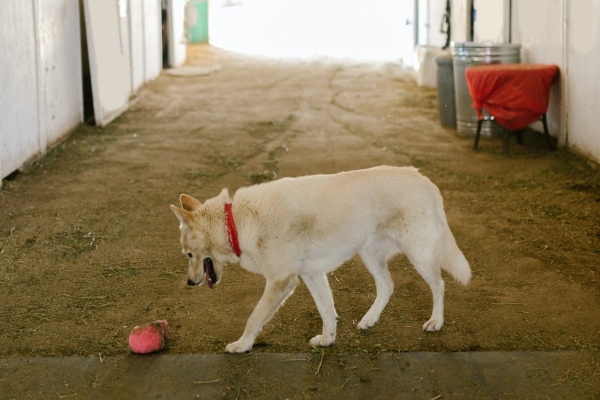
Additionally, there are some other potential causes of anemia aside from IMHA that fall into this category. They include:
- Toxins (many of which cause a specific type of anemia called Heinz body anemia in dogs)
- Zinc
- Onions
- Garlic
- Acetaminophen
- Damage to red cells as blood flows through abnormal blood vessels (i.e. microangiopathic hemolysis)
- Severe heartworm disease in dogs
- Hemangiosarcoma
- Splenic torsion
- Severely low blood phosphorus levels from another underlying condition
- Diabetic ketoacidosis in dogs
- Refeeding syndrome (i.e. a condition which occasionally occurs in dogs who were chronically malnourished and begin to receive nutrition again)
- Infectious disease including:
- Distemper
- Parvo
- Babesia
- Bartonella
- Anaplasmosis
3. Anemia in dogs due to decreased production of red blood cells
The bone marrow constantly makes red blood cells to replace the old or damaged cells that the body takes out of circulation. Therefore, anything that slows or halts the production of new red blood cells within the bone marrow will lead to anemia.
The most common cause of mild to moderate non-regenerative anemia (i.e. anemia where the body isn’t producing new red blood cells to replace the lost ones) is chronic diseases that suppress red blood cell production (i.e. anemia of chronic disease). This happens because any significant and long-lasting disease process can cause the body to divert energy away from red blood cell production.
Some other conditions that can cause the bone marrow to not produce enough red cells include:
- Cancers affecting the bone marrow
- Leukemia
- Lymphoma in dogs
- Poor nutrition, starvation, or deficiencies in:
- Iron
- B vitamins
- Copper
- Bone marrow disease
- Kidney failure in dogs (moderate or severe)
- Autoimmune diseases
- Aplastic anemia
- Scarring of the bone marrow (i.e. myelofibrosis)
- Situations where the bone marrow makes abnormal blood cells (i.e. myelodysplasia)
- Toxicity
- Medication side effects (e.g. chemotherapy drugs)
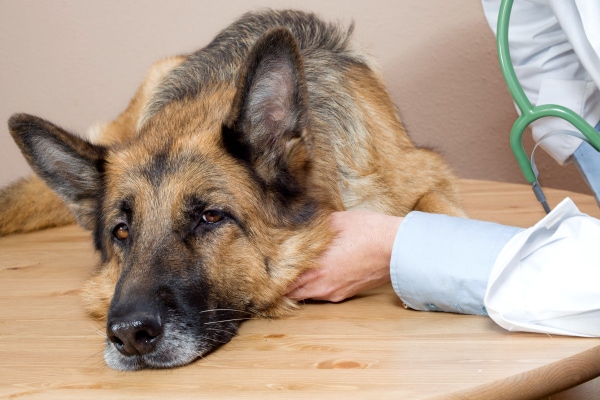
How does the vet determine which type of anemia a dog has?
As you can see, anemia can be a symptom of a vast number of conditions. Thus, the vet will have to do some detective work to figure out which type of anemia your dog has and why it is happening. This will involve:
Finding out about your dog’s history
First, your veterinarian will gather a thorough history to help narrow down the cause of your canine companion’s anemia. He or she will ask questions about:
- How long any concerning signs have been present
- Your dog’s diet
- Medication and supplement use (prescription or over-the-counter)
- Your dog’s preventative care regimen (i.e. vaccinations, routine wellness visits, and flea, tick, intestinal parasite, and heartworm preventive use)
- Any potential exposure to toxins
Performing a physical examination
Next, your veterinarian will carry out a nose-to-tail physical exam. First, he or she will check your dog’s vitals and assess the gum color. This will help your vet determine how severe the problem is and if your dog requires emergency stabilization.
If your dog is stable, the vet will spend time palpating your dog’s internal organs and lymph nodes. He or or she will also look for any evidence of bruising or external parasites like fleas. A rectal exam, while not terribly fun for your canine companion, is another important part of the physical exam for all anemic dogs. It can help your veterinarian determine if your dog has black tarry stool or red stool. Either of those stool colors could indicate a GI bleed as the cause of the anemia.
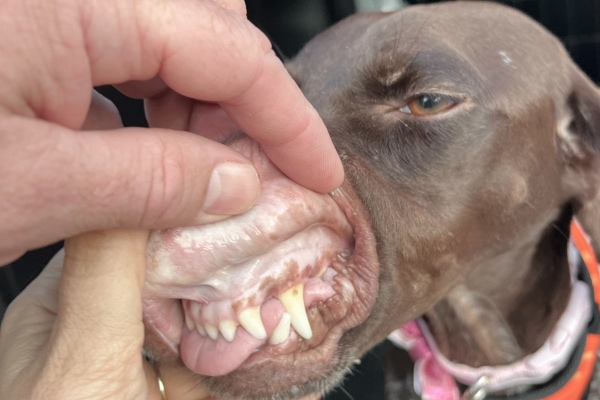
Determining if the canine anemia is regenerative or non-regenerative
Your veterinarian will also attempt to figure out if the anemia is regenerative or non-regenerative as part of the investigation. This typically involves using a blood smear or a CBC to assess the number of reticulocytes (i.e. baby red blood cells) in your dog’s blood. If your dog’s anemia is regenerative, that means the bone marrow is trying to make up for the anemia by pumping out reticulocytes. It is “regenerating” red blood cells.
On the other hand, if your dog is anemic and the reticulocyte count is NOT high, the dog has a different form of anemia, aplastic or non-regenerative anemia. That can simply mean the bone marrow has not had time to kick into high gear and make extra red cells. However, if after five to seven days there are still no extra reticulocytes and the anemia remains non-regenerative, the problem most likely lies with the bone marrow’s ability to make red blood cells.
Said another way, if the anemia is non-regenerative, your veterinarian will focus on causes in the “decreased production” category above. And if the anemia is regenerative, the cause probably lies in the “blood loss” or “destruction of the red blood cells” categories. Thus, a simple reticulocyte count can go a long way in narrowing down the list of causes.
Performing additional testing
However, even with the list of causes narrowed down a bit by the history, physical exam, and CBC or blood smear, there are still a lot of options left. Your vet will work closely with you to decide which additional tests will be most useful to pin down the specific condition causing the anemia.
Some of the more common tests include:
- More bloodwork
- Fecal tests for dogs
- Chest X-rays
- Abdominal X-rays or an abdominal ultrasound
- Infectious disease testing (e.g. testing for tick-borne diseases in dogs)
- Bone marrow testing
Depending on the severity or complexity of the situation, your vet may also discuss referral to a veterinary specialist near you—usually an internal medicine specialist.
What is the treatment for anemia in dogs?
Once your veterinarian diagnoses your beloved canine companion with anemia, the first step will be to determine if this anemia is severe enough to warrant a blood transfusion in dogs.
Blood transfusions for anemia in dogs
The blood count results alone won’t determine if your dog needs a transfusion. This is the case because dogs with chronic anemia can often remain stable with more severe decreases in their red blood counts. But dogs with sudden bleeding (or other causes of sudden anemia in dogs) may be unstable after losing a lower quantity of blood.
For this reason, your veterinarian will assess your dog’s vitals and use those parameters, along with the physical exam and blood counts, to make a decision about a transfusion.
Most dogs can have their first blood transfusion without any additional testing to ensure the donor blood is compatible. After a few days, however, your dog will have had time to make antibodies to certain types of blood. This means that any additional blood transfusions will require a test known as a crossmatch.
Cause-specific treatments for anemic dogs
Aside from a blood transfusion in cases of severe anemia, there is no other universal treatment for anemia in dogs. Instead, the treatment depends largely on the underlying cause of the anemia.
For example, if your pup’s anemia is due to a gastrointestinal ulcer, your vet may recommend GI protecting medications like omeprazole for dogs. Or if the anemia is from an autoimmune condition like IMHA, your dog may need immunosuppressive medications like prednisone for dogs. And if the anemia is from cancer, your vet might discuss chemotherapy.
The list of possible things to do for a dog with anemia goes on and on. And the treatments are just as variable as all the potential causes. While this may seem overwhelming, rest assured that your veterinarian will work closely with you to get your beloved dog on the right treatments.
There are diets, foods, or supplements that may help boost red blood cells numbers in some cases. However, there are no uniformly good ways to treat dogs for anemia at home. Plus, any natural or holistic treatments for anemia in dogs may not be sufficient to address the underlying cause or correct moderate or severe anemia in a timely fashion. Relying on your vet’s advice really is the best plan.

What is the prognosis for dogs with anemia?
Just as the options for treating anemia in dogs are quite variable, so is the prognosis. Your veterinarian will ensure you understand your dog’s specific situation. And he or she can help prepare you for exactly what to expect regarding your dog’s prognosis.
In general, mild to moderate anemia in dogs has a much better prognosis. Your veterinarian will have more time to get to the bottom of the cause. Also, your dog will be more stable, which allows time for the prescribed treatments to take effect.
Unfortunately, the prognosis for severe anemia in dogs is more guarded. But even still, some dogs with severe anemia, such as from IMHA, can respond well with blood transfusions and aggressive treatment. They may even go on to recover completely.
Are there ways to prevent anemia in dogs?
Understandably, talking about the outlook for anemic dogs also raises the question about preventing your dog from becoming anemic. In keeping with most other aspects of anemia, the answer to the question of prevention varies based on the cause of the anemia.
There probably isn’t anything you can do to keep your dog from getting a splenic tumor or chronic kidney disease. However, you can ensure your dog is on year-round heartworm, flea, tick, and intestinal parasite preventives. Additionally, you should allow your vet to run yearly heartworm tests and fecal tests on your dog to screen for heartworms or intestinal parasites.
You can also ensure that all toxins are out of your dog’s reach, and promptly contact your vet should you have any concerns about your dog’s health. The sooner your dog gets help for anemia, the better.
Tackle anemia in dogs with the help of your vet
Hopefully, you made it through this article without feeling too queasy. If so, you now know the signs of anemia in dogs that you should keep an eye out for. Keep them in mind and make it a regular habit to check your dog’s gum color as part of your at-home dog wellness scan.
If you find yourself suspecting your dog is anemic, remember that a trip to visit your veterinarian is the first order of business. You can use your new-found understanding of anemia to work closely with your veterinarian and advocate for your dog. With your diligent care and unconditional love, and your vet’s deep knowledge and expertise, your pup will hopefully be on the road to recovery in no time.
Have you dealt with anemia in your dog?
Please comment below.


Hi Sarah,
My dog is lil old he might around 13 years. Since last days he has black potty, also other symptoms like pale gums, last two legs collapsing, vomiting, weakness, lethargic, and he also beginning stage bronchitis, spondylitis, heart enlargement but all are in initial stage. Also, his haemoglobin is 10, wbc is 26000. After seeing vet he said he has hookworm so we did medication n antibiotics for five days. We were told he would fine after five days he didn’t infact he is not eating at all. Can you pls help seems like my vet doesn’t know much about.
Hi Vidhi,
I am sorry your senior guy is sick and not doing well. I know you want to do whatever you can to help restore his health and well-being. Unfortunately, without examining him myself, it is hard to offer specific conclusions and recommendations. It is ok to get a second opinion if you are not sure about the level of care your pup has received. Hookworms can definitely cause many of the symptoms you are describing. It may be that due to all the other conditions your boy is living with, his body is just not able to recover as expected. Hoping you can get the answers you need and praying for a positive outcome for your senior pup.
Martin Road mixed breed rescue dog. He came lethargic last week.. Friday we took him to the vet and he was severely anemic with his HCT at 9. The x-ray showed no internal bleeding. They administer the unit of packed red blood cells and started him on some medication’s to help with his hemoglobin.. that night, he began vomiting, which was a new symptoms, and they said he was vomiting blood. So we had to do an ultrasound.. the ultrasound came back clear with no tumors are masses or indication of internal bleeding. So they assume this is an auto immune disorder. After the blood transfusion is hematocrit went up to 13.8. They started him on medication’s to increase his hemoglobin.. he maintained in the 13s Saturday, Sunday and Monday. I get the call today that he is drop back to 10. 😞. I just drove two hours to pick up another unit of packed red blood cells. From what I understand his blood is rare. 🤷♀️. So let’s hope this unit in addition to the medication’s work. They say his kidney function is working because he is making a lot of relics.
We are praying for a miracle I feel like.
Dear Sarah,
My heart goes out to you as you face this difficult situation with your pup. This condition can be very tricky to treat, and some dogs just don’t respond to the medications. Here is a link to another article with more information: IMHA in Dogs: A Comprehensive Guide
It sounds like the veterinary team is doing all they can to give your boy the best shot at recovery. Praying for healing and wishing your pup all the best as he continues to fight.
Dear Dr. Buzby,
my 13 year old big dog has kidney failure. we.managed to get his BUN and Creatinine stable with subcutaneous fluids every other day. his anemia was stable, but in the past couple weeks his hemoglobin dropped to 8 and his HCT went from 32 a couple weeks ago to 24. Trying darbopoetin has been touched on, but it’s super expensive in a 57 lb dog. We are trying weekly iron dextran injections to see if it helps. I was wondering if you had any other ideas in what to try to being up hemoglobin in a dog with kidney disease? His reticulocytes are just below normal. Any ideas you can recommend I discuss with my vet? I want to make sure I can get my boy a chance to bounce back. he had been doing well. thank you
Hi Kat,
I understand your concern for your senior guy and commend you for taking such an active role in advocating for his health and well-being. I am not aware of any other treatment option other that what you have already mentioned. It may be worth asking for a consultation with an internal medicine specialist. They would have more information on all the possible treatments and therapies available for this specific issue. Hoping you can find a clear path forward and praying for healing for your sweet boy.
I’m crying as I’m reading this because my NSDTR who will be 14 next month is currently at the vet receiving IV fluids for severe anemia, possibly due to his kidney disease. Up until yesterday afternoon he was doing great, lots of walks, eating, happy. Then last night the black stool came as a symptom and we took him straight to the vet this am. I am hoping that the fluids, along with antibiotic and something to soothe the tummy, (I don’t know exactly which meds were given yet) will bring him back. In your experience, if the anemia is due to the kidneys, (his stool sample was negative for parasites) he can get back to health again? Last night and this morning he was SO weak and could barely stand up but he sure tried, he’s a fighter. He beat melanoma in 2022 and has been handling CKD like a champ. Thank you!
Hi Jennifer,
I am sorry your boy is facing this unknown issue and I understand why you are worried. There are medications that can be used to help the body produce more red blood cells and sometimes kidney function can be restored a bit with intensive fluid therapy. What has me concerned is that you are seeing black stool. This is a sign of blood loss into the GI tract. This is not usually seen with anemia due to kidney failure. The kidneys produce substances that stimulate red blood cell (RBC) production. So, if the kidneys aren’t functioning properly the body just doesn’t make enough RBCs. But anemia due to blood loss (whether into the GI tract or internally into the abdomen) is a whole different situation. Hoping your vet was able to narrow down the cause and start the appropriate treatment. Feel free to leave an update and let us know how things are going. Praying for healing and a positive outcome for your sweet boy.
Dear Dr. Buzby,
I’d like to share my story, though it won’t bring my girl back to life. Not knowing what exactly had happened is filling me with even more grief and guilt. My 13 years old mutt was a very healthy dog ageing very gracefully a part from some joint stiffness. In September 2022, all of a sudden, she had to be brought to ER for an abdominal bleeding caused by the rupture of an adrenal tumor. She had to have a life saving surgery and recovered very well (the histologic examination suggested a benign neoplasia). Around July 2023 she started to drink excessively and being more lethargic, but I associated the symptoms with the hot weather we were experiencing. I didn’t think to check her gums and when I did at the beginning of September, they were extremely pale and I rushed her to the vet to do bloodworks, xrays and ultrasound. While the ultrasound showed a big mass on the right side of her liver, the CBC showed a beginning of anemia (regenerative) and platelets a little low. Liver enzymes were elevated. The vet sent me home saying that the next step would be a liver biopsy. It was the first time I was going to this practice so I brought her to a well known vet to have a second opinion and a new ultrasound and repeat all the blood works. 2 weeks had passed and my girl had started showing heavier symptoms such as lack of appetite and labored breathing. The anemia was getting worst and the platelets lower, lipase, amylase and urea were high this time, The vet said that there was nothing which could have been done to save her as the mass was big and a biopsy would have been very risky du to her age and other blood values out of range. He said that it was most likely cancer and only prescribed her palliative meds such as Denamarin for the liver, gastroprotector and antinausea. But nothing was given for the anemia (I had no idea then and had total trust in the vet). He told me to keep her comfortable and let her be as long as there was quality of life. Unfortunately she declined rapidly and after 2 weeks she could barely get up, stopped eating and could not sleep at night any longer because of the labored breathing. I brought her to the vet again to check her blood values and she barely had any platelets left, HGB and HCT nearly inexistent, urea, lipase and amylase skyrocketing, all her organs were basically shutting down and there was absolutely nothing I could do, or at least this is what my vet said. He just prescribed oral antibiotics as the white cells were elevated, and potassium supplements. But nothing worked and she refused all medication, there was no way to put something inside of her body. After 2 days following the last vet visit, when she couldn’t stand anymore nor sleep at all and being in a semi coma state all day, I had to take the worst decision of my entire life and helped her crossing over. This was October 7th, 2023. Writing that I am devastated is an understatement, but what makes me feel even worst is the fact that nothing was given for the anemia. Maybe she could have lived longer if the anemia could have been managed? Maybe it would have given me time to bring her to an IMS oncologist for another opinion? It might have not been cancer but just a liver infection/intoxication? Since her loss, I have been spending days and nights researching the different liver diseases and what might have caused her such a strong anemia and loss of platelets. She didn’t have any internal bleeding from the 2 ultrasounds she did (only the first one showed a small fluid layer by her kidneys which had gone at the second one). She and my other senior dog were exposed to cyanobacteria (blue-green algae) a few times during the summer and was wondering if it might have been the culprit? My other dog is ok though. I would much appreciate your input and thoughts.
Dear Sara,
My heart aches for you as you grieve the loss of your beloved girl. I understand how your mind ponders all the “what ifs” and leaves you with more questions than answers. Since I did not have the opportunity to examine your pup myself, it is hard to make conclusions about how things progressed. With the presence of a tumor on her liver, I am not sure that treating the anemia would have extended her life. It may have offered a few extra days or weeks, but ultimately, I feel she would have faced the same fate. I think you made a loving choice to offer your girl freedom and peace. I would have done the same for one of my own. We may never know what caused her health to begin to decline, sometimes it’s just genetics and bad luck. I hope with time your heart will begin to heal and the grief will fade. May her memory stay with you always and be a blessing in your life. Wishing you brighter days ahead as you continue life’s journey. ♥
Hi Julie we have just 3 days ago lost our beloved 11 year old GSD Nala. I am still trying to understand how we lost her and why, as I was not able to go to the vet with her. My partner went as I was home caring for our three kids. I have some information from the blood test they did on the day she was put to sleep. Her RBC was low 3.1×10-12/L, her HCT was 17.8%, her HGB was 6.6 g/dL, her MCV was 57.4 fL and her retic was high with 202.7 K/uL. I suppose I am trying to understand whether she would have been a candidate for a blood transfusion or if her anemia was so severe that it was too late. The vet did a physical exam and found a tumour the size of a banana near her spleen so I suspect she had hermangiosarcoma. Surgery was offered but they pushed more for euthanasia. I know you cannot give specific advice but we knew she was getting weaker and took her to the vet 10 days before the day she died and a simple blood test was taken that day and the following day but anemia and the tumour were not found then. Arthritis was the given suspect for her weakness. Could we have had her for a little bit longer or was she at the end already with the PCT results? I miss her terribly and I know I shouldn’t think of the what ifs but we lost her so suddenly and I am in pain thinking about this all. Thank you for this page. I have spent a big chunk of last night reading and understanding what she might have had and why she is not with us. It helps in knowing what we did was the right thing to do for her.
Dear Brigitte,
I am so sorry for your loss of Nala. I understand how your mind runs through all the “what ifs” and leaves you with more questions than answers. From what you describe, I definitely think you made the right choice for Nala. Even if you had found the splenic mass 10 days earlier, I am not sure surgery would have been an option or that the outcome would have been any different. You made a loving choice to offer your beloved pup freedom from her suffering. I would have done the same for one of my own. I hope as time passes your grief will fade and your heart will begin to heal. May Nala’s memory always be a blessing to you and your family. Wishing you brighter days ahead as you continue life’s journey.
My 9 year old mutt was diagnosed with immune mediated non-regenerative anemia in November of 2021. She has a PCV of 15% when she was diagnosed. A blood transfusion raised her to 20%, and we started her on Prednisone and Azathioprine, since all diagnostic tests she was given seemed to rule out cancers or intestinal bleeds, and there were no signs of infections from parasites. Pippa has always been on Heartguard and Nexguard, and was always current on vaccines.
Things were not going well for Pippa, as she needed a second transfusion in several days, and was needed them weekly. In late November, she started acupuncture, and was given some eastern medication, like Deer Velvet Pentagenesis. Within days, Pippa began to hold her own in regards to her PCV, and as time went on, she she was gaining in her PCV without transfusions. Pippa’s last transfusion was November 24, 2021. She did go out of remission in April, 2022, but knowing what to look for, got me starting her back on Prednisone and upping her dose of Azathioprine, and she bounced back without needing any transfusions. Her current PCV is 49%. We are continuing with a combination of Western and Eastern medicine, as well as acupuncture, laser, and a PEMF mat. We will not be giving Pippa any more vaccines, as there is a correlation between Pippa’s vaccine and the onset of the anemia. She will be titred, and she is and has always been kept in the home, and only walked on a leash, or been under our supervision.
I will not give up on Pippa, and hope and expect that she will live a long, happy, doglike life!
If there are any additional treatments that develop for a dog like Pippa, I will do them for her. She’s a remarkable dog!
Hi Anita,
Thank you so much for sharing your story with our readers. I hope your experience will be able to help someone else in a similar situation. I am very intrigued about the eastern medicine that was included in Pippa’s treatment regimen. I love Deer Antler Velvet which is a main ingredient in Encore Mobility. I am glad you found the right combination of therapies to help restore Pippa’s PCV and quality of life. I hope she will continue to thrive and have many happy years ahead for making memories. Bless you and wishing you both the best!
So is Deer Velvet Pentagenesis an ingredient found in supplements not the actual supplement?
Hi Vanessa,
Penta Genesis is an actual brand name of a supplement. The word “penta” means 5 and this supplement brand contains 5 main ingredients. Here is a link to their website: https://nzdeervelvetproducts.co.nz/penta-genesis/
Deer Velvet is an amazing thing! Thats is why it is also one of the ingredients in our supplement Encore Mobility. Here is a link to an article with more information: Deer Antler Velvet: The Science Behind the Supplement
Anita the start of your story sounds very similar to ours start which only began 3 weeks ago. We are trying to help our Bentley get her levels up. Could you provider more information about the acupuncture and the Easter. Medication we are reaching ever avenue for hope. Bentley had her second transfusion and currently on prednisone and mycophenolate mofetil. Hopefully you see this !